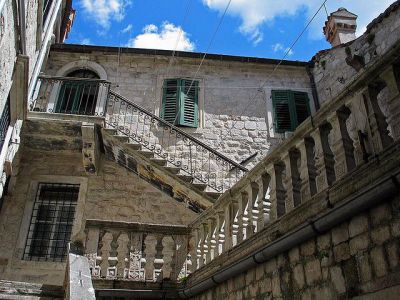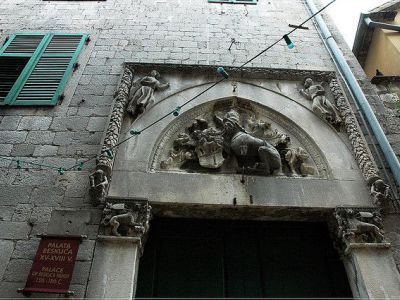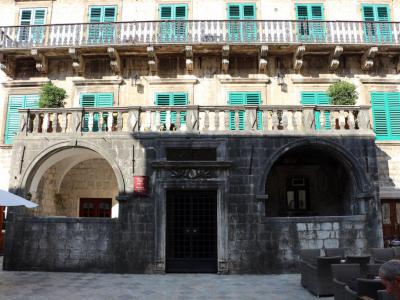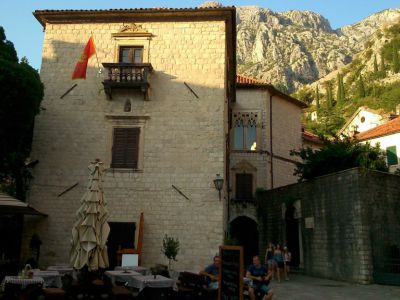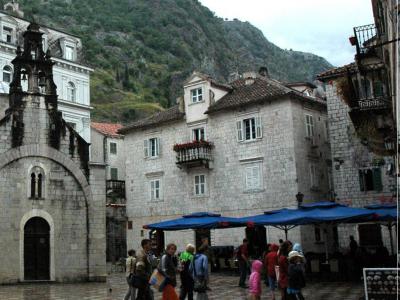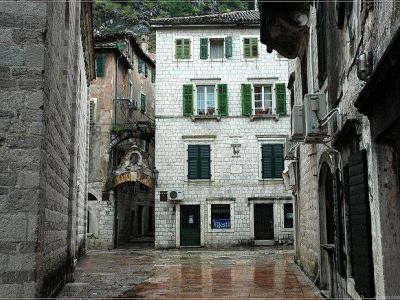
Kotor Palaces Walking Tour (Self Guided), Kotor
This magnificent historic city is home to a number of wonderful palaces. Many of these beautifully ornamented mansions belonged to wealthy and influential families. Visitors can trace the history of each building by looking at the coats of arms of noble families and the paintings on the walls. Take this self-guided tour to see these beautiful historical palaces in Kotor.
How it works: Download the app "GPSmyCity: Walks in 1K+ Cities" from Apple App Store or Google Play Store to your mobile phone or tablet. The app turns your mobile device into a personal tour guide and its built-in GPS navigation functions guide you from one tour stop to next. The app works offline, so no data plan is needed when traveling abroad.
Kotor Palaces Walking Tour Map
Guide Name: Kotor Palaces Walking Tour
Guide Location: Montenegro » Kotor (See other walking tours in Kotor)
Guide Type: Self-guided Walking Tour (Sightseeing)
# of Attractions: 7
Tour Duration: 1 Hour(s)
Travel Distance: 0.4 Km or 0.2 Miles
Author: emily
Sight(s) Featured in This Guide:
Guide Location: Montenegro » Kotor (See other walking tours in Kotor)
Guide Type: Self-guided Walking Tour (Sightseeing)
# of Attractions: 7
Tour Duration: 1 Hour(s)
Travel Distance: 0.4 Km or 0.2 Miles
Author: emily
Sight(s) Featured in This Guide:
- Palata Bizanti (Bizanti Palace)
- Palata Beskuca (Beskuca Palace)
- Palata Pima (Pima Palace)
- Palata Drago (Drago Palace)
- Museum Maritimum (Maritime Museum - Grgurin Palace)
- Palata Lombardic (Lombardic Palace)
- Palata Grubonja (Grubonja Palace)
1) Palata Bizanti (Bizanti Palace)
Situated in the busy Arms Square, the Bizanti Palace traces its roots back to the 14th century. Today, it stands as a fine example of Renaissance architecture infused with Baroque elements, still bearing the initials and coat of arms of the esteemed Bizanti family. The ground floor accomodates a post office, along with several souvenir shops.
The Bizanti family, whose lineage dates back to the 11th century, has produced a host of notable individuals including captains, professors, and priests. Among them, Nikola Bizanti, a distinguished city judge, stands out. Following the earthquake of 1667, he spearheaded the reconstruction efforts of both the palace and the family residence, leaving a lasting legacy.
Along the street lies the entrance to the courtyard of the family home, open to visitors at no charge. Here, guests can marvel at the remnants of a bygone era: a quaint stone staircase, elegant balconies, and a weathered water well, evoking a sense of pure romance.
The Bizanti family, whose lineage dates back to the 11th century, has produced a host of notable individuals including captains, professors, and priests. Among them, Nikola Bizanti, a distinguished city judge, stands out. Following the earthquake of 1667, he spearheaded the reconstruction efforts of both the palace and the family residence, leaving a lasting legacy.
Along the street lies the entrance to the courtyard of the family home, open to visitors at no charge. Here, guests can marvel at the remnants of a bygone era: a quaint stone staircase, elegant balconies, and a weathered water well, evoking a sense of pure romance.
2) Palata Beskuca (Beskuca Palace)
The Beskuća Palace stands on the street leading from the Arms Square to the Flour Square, opposite the Bizanti Palace, and was constructed in 1776, replacing older structures that occupied the site. It is believed that one of these structures was the residence of the prominent Bizanti family, from which the palace inherited its portal.
Featuring a simple architectural design with clean lines and minimal decorative elements, the palace is distinguished primarily by its aforementioned Gothic portal, widely regarded as a masterpiece of floral Gothic architecture along the entire eastern Adriatic coast. At its center is the family's coat of arms, depicting a winged lion, while below it, a Latin inscription reads: "Si deus com nobis, quis contra nos" ("If God is with us, who can be against us").
Originally belonging to the Beskuća family from Prčanj, the palace signifies the family's ascent to prominence in the late 18th century, fueled by their success in maritime trade. Bestowed with nobility, the family amassed considerable wealth and possessed numerous estates and residences across the Bay of Kotor, as well as in Venice and Constantinople.
Featuring a simple architectural design with clean lines and minimal decorative elements, the palace is distinguished primarily by its aforementioned Gothic portal, widely regarded as a masterpiece of floral Gothic architecture along the entire eastern Adriatic coast. At its center is the family's coat of arms, depicting a winged lion, while below it, a Latin inscription reads: "Si deus com nobis, quis contra nos" ("If God is with us, who can be against us").
Originally belonging to the Beskuća family from Prčanj, the palace signifies the family's ascent to prominence in the late 18th century, fueled by their success in maritime trade. Bestowed with nobility, the family amassed considerable wealth and possessed numerous estates and residences across the Bay of Kotor, as well as in Venice and Constantinople.
3) Palata Pima (Pima Palace)
Once hailed as Kotor’s most exquisite palace of the 17th century, this grand abode was once the stately home of the esteemed Pima family, whose members included renowned poets Jerome and Bernard. Despite enduring the ravages of countless earthquakes over the years, the structure rose from the ashes following the catastrophic tremor of 1667 and again after the one in 1979. Today, its main portal proudly showcases the Pima family coat of arms, upheld by two angelic figures.
With a touch of imagination and a squint of the eyes, one can conjure a glimpse of the palace's former splendor. A harmonious blend of Renaissance and Baroque styles, adorned with intricate balconies, the façade's green shutters serve to divert attention from the now weathered exterior. On the ground floor, the Galerija Solidarnosti takes center stage – a museum showcasing artworks by artists and sculptors from former Yugoslavian countries, as well as the United States, Poland, Romania, and beyond.
With a touch of imagination and a squint of the eyes, one can conjure a glimpse of the palace's former splendor. A harmonious blend of Renaissance and Baroque styles, adorned with intricate balconies, the façade's green shutters serve to divert attention from the now weathered exterior. On the ground floor, the Galerija Solidarnosti takes center stage – a museum showcasing artworks by artists and sculptors from former Yugoslavian countries, as well as the United States, Poland, Romania, and beyond.
4) Palata Drago (Drago Palace)
Nestled within Saint Tryphon's Square, this palace maintains a distinctive dual character across its two sections. The northern part, crafted in the Gothic style prevalent during the 14th to 16th centuries, exudes an aura of medieval charm, with its windows and portals nicely chiseled out. In contrast, the southern portion, constructed in the 17th century, showcases a blend of Baroque and Renaissance influences.
Adding to its allure, the palace often features a dragon motif, symbolizing the Drago family, who wielded significant influence in Kotor from the 13th to the 18th century. Renowned for their contributions to culture, art, economics, and politics, the Dragos owned the edifice from the 14th century until the early 19th century, when it passed into the city's hands.
Following the seismic upheaval of the 1979 earthquake, the Drago Palace found new purpose as the home of the Regional Institute of Cultural Preservation, safeguarding and celebrating the rich heritage of the region.
Adding to its allure, the palace often features a dragon motif, symbolizing the Drago family, who wielded significant influence in Kotor from the 13th to the 18th century. Renowned for their contributions to culture, art, economics, and politics, the Dragos owned the edifice from the 14th century until the early 19th century, when it passed into the city's hands.
Following the seismic upheaval of the 1979 earthquake, the Drago Palace found new purpose as the home of the Regional Institute of Cultural Preservation, safeguarding and celebrating the rich heritage of the region.
5) Museum Maritimum (Maritime Museum - Grgurin Palace)
Kotor's rich maritime legacy takes center stage in a beautiful early-18th-century Baroque palace, housing three floors of captivating displays. With the help of an audio guide, you'll dive into a treasure trove of photographs, paintings, uniforms, intricately crafted weapons, fancy navigational gadgets, and ship models.
The sailing tradition in Kotor traces back to medieval times, and you can soak in the tales of Kotor's seafarer fraternity, known as the Boka Marine, dating all the way back to the 9th century. The museum is like a time capsule, preserving memories of the city's illustrious seafarers, artists, shipbuilders, craftsmen, politicians, and diplomats who bridged the gap between East and West.
Among the highlights are six bronze relief tables showcasing pivotal events and notable figures from Kotor's turbulent past. You'll also find geographic maps, engravings, and watercolors depicting coastal towns, along with an ethnographic collection that offers a glimpse into Kotor's maritime heyday from the 16th to the 18th century.
Right at the entrance of the palace, keep an eye out for two small cannons symbolizing the endless battle between seafarers and pirates.
The sailing tradition in Kotor traces back to medieval times, and you can soak in the tales of Kotor's seafarer fraternity, known as the Boka Marine, dating all the way back to the 9th century. The museum is like a time capsule, preserving memories of the city's illustrious seafarers, artists, shipbuilders, craftsmen, politicians, and diplomats who bridged the gap between East and West.
Among the highlights are six bronze relief tables showcasing pivotal events and notable figures from Kotor's turbulent past. You'll also find geographic maps, engravings, and watercolors depicting coastal towns, along with an ethnographic collection that offers a glimpse into Kotor's maritime heyday from the 16th to the 18th century.
Right at the entrance of the palace, keep an eye out for two small cannons symbolizing the endless battle between seafarers and pirates.
6) Palata Lombardic (Lombardic Palace)
Stretching across an entire city block in the northern reaches of Kotor's urban core, the Lombardić Palace commands attention with its presence. Its northern facade overlooks the square adjacent to the Church of Saint Luke, while its southern aspect overlooks another quaint square housing the Karampana fountain.
Erected in the mid-18th century, this is a typical Baroque residential block, with finely crafted elements characteristic of the era: a rustic stone portal, elegantly profiled window frames, and balconies with stone balustrades on both the northern and southern facades. Atop the main facade sits a small turret, featuring characteristic Baroque volutes at the juncture with the roofline.
During the years 1804 to 1806, the palace served as the abode of the Russian consulate.
Erected in the mid-18th century, this is a typical Baroque residential block, with finely crafted elements characteristic of the era: a rustic stone portal, elegantly profiled window frames, and balconies with stone balustrades on both the northern and southern facades. Atop the main facade sits a small turret, featuring characteristic Baroque volutes at the juncture with the roofline.
During the years 1804 to 1806, the palace served as the abode of the Russian consulate.
7) Palata Grubonja (Grubonja Palace)
Next to the northern city gates, just at the threshold of Saint John's Castle and behind the Church of Saint Mary Collegiate, stands this venerable 17th-century palace. While the history of the Grubonja family, who settled in Kotor from Zadar in the 15th century, remains somewhat shrouded in mystery, their legacy endures through the remarkably resilient structure, which emerged unscathed from the tremors of both the 1979 and 1667 earthquakes.
On its main facade is a striking coat of arms, featuring an intriguing array of symbols: skeletal bones, a skull, a snake, a turtle, and a lizard. This emblem is widely regarded as the symbol of Kotor's first pharmacy, established in 1326 and ranking among Europe's oldest. Adjacent stands a red-gray portal, serving as the gateway to the city walls, featuring the likeness of a winged lion – the iconic symbol of the Republic of Venice – and bearing a Latin inscription, "Regia munitae rupis via", meaning "The main road to the fortress in the mountain".
On its main facade is a striking coat of arms, featuring an intriguing array of symbols: skeletal bones, a skull, a snake, a turtle, and a lizard. This emblem is widely regarded as the symbol of Kotor's first pharmacy, established in 1326 and ranking among Europe's oldest. Adjacent stands a red-gray portal, serving as the gateway to the city walls, featuring the likeness of a winged lion – the iconic symbol of the Republic of Venice – and bearing a Latin inscription, "Regia munitae rupis via", meaning "The main road to the fortress in the mountain".
Walking Tours in Kotor, Montenegro
Create Your Own Walk in Kotor
Creating your own self-guided walk in Kotor is easy and fun. Choose the city attractions that you want to see and a walk route map will be created just for you. You can even set your hotel as the start point of the walk.
Kotor Old City Walking Tour
Nestled on the shores of the Bay of Kotor and at the foot of the surrounding mountains, the beautiful fortified city of old town Kotor is a UNESCO World Heritage Site. While it receives less attention than many other settlements from the same period, Kotor is visited by more tourists every year.
The port here has been in use since Ancient Roman times, but most of the fortifications were built... view more
Tour Duration: 2 Hour(s)
Travel Distance: 2.2 Km or 1.4 Miles
The port here has been in use since Ancient Roman times, but most of the fortifications were built... view more
Tour Duration: 2 Hour(s)
Travel Distance: 2.2 Km or 1.4 Miles
Kotor's Historical Churches Walking Tour
Kotor, a picturesque coastal town in Montenegro, albeit small, nonetheless, boasts a surprising number of historical churches that beautifully reflect its centuries-old heritage. Many of these temples are richly decorated with frescoes, some dating as far back as the 1300s.
At the heart of the town lies Saint Tryphon Square dominated by the eponymous cathedral, an iconic landmark from the 12th... view more
Tour Duration: 1 Hour(s)
Travel Distance: 0.5 Km or 0.3 Miles
At the heart of the town lies Saint Tryphon Square dominated by the eponymous cathedral, an iconic landmark from the 12th... view more
Tour Duration: 1 Hour(s)
Travel Distance: 0.5 Km or 0.3 Miles
The Most Popular Cities
/ view all
